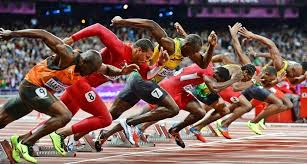More than just speed: What it really takes to compete at the highest level
When we watch the 100-meter dash, it’s over in the blink of an eye often less than 10 seconds of explosive brilliance. But what we don’t see is the lifetime of dedication, sacrifice, and grueling work behind each step. World-class sprinters aren’t just fast they are among the most finely tuned athletes on Earth, balancing peak physical performance with unshakable mental discipline.
The Physical Grind: Building a Human Rocket
Sprinting is one of the purest expressions of athleticism. It combines strength, speed, balance, coordination, and flexibility. Sprinters train year-round, meticulously breaking down every phase of their race the start, acceleration, drive phase, and top-end speed.
Key Elements of Physical Training:
- Strength & Power Development
Sprinting starts in the gym. Olympic lifts, squats, deadlifts, and sled pushes develop the raw power needed to explode off the blocks and drive forward with force. Lower body strength, in particular, is a cornerstone of sprint performance. - Speed and Technique Work
Speed drills, sprint mechanics, and resistance runs are staples of daily training. Coaches use video analysis to perfect form arm swing angles, stride length, hip height, and foot placement are analyzed and corrected frame by frame. - Flexibility and Recovery
Hamstrings, calves, and hip flexors take enormous stress during sprints. Stretching routines, massage therapy, cryotherapy, and even acupuncture are common. A single tight muscle can lead to a tear and potentially months off the track. - Nutrition and Body Composition
Maintaining the perfect balance of lean muscle mass and low body fat is essential. Many sprinters work with dietitians to fine-tune macros and hydration. Supplements like creatine and amino acids help aid recovery and performance.
The Mental Battle: Winning Before the Race Even Starts
Sprint races are won in split seconds, but the mind of a sprinter is constantly racing. The mental side of sprinting is often underestimated, yet it’s what separates great athletes from legends.
Psychological Tools of Champions:
- Visualization and Mental Rehearsal
Sprinters often “run the race” hundreds of times in their minds. Visualization techniques help them internalize every movement and scenario, including perfect starts and finishing strong under pressure. - Pressure Management
One false start can end a season or a career. The mental intensity at the starting blocks is overwhelming. Athletes use breathing techniques, mindfulness, and mental routines to stay calm and focused. - Resilience and Recovery from Setbacks
Injuries, disappointing results, and public scrutiny can break an athlete. Elite sprinters must have the mental toughness to bounce back stronger. Usain Bolt famously overcame early-career injuries and doubts to become the fastest man alive. - Routine and Superstition
Many top sprinters follow strict pre-race rituals from the order they put on their spikes to the music they play in their headphones. These rituals help create a sense of control and familiarity in high-stakes moments.
Legends of the Track: Setting the Gold Standard
Sprint icons like Usain Bolt, Florence Griffith-Joyner, and Carl Lewis changed the game not just with their speed but with their presence. Bolt brought a new swagger to sprinting, turning every race into a spectacle. Flo-Jo shattered expectations of femininity and power, setting records that still stand decades later. Their greatness came not just from talent, but from the relentless pursuit of perfection.
Modern athletes like Shelly-Ann Fraser-Pryce, Noah Lyles, and Sha’Carri Richardson continue to elevate the sport pushing limits with every race and proving that the mental and physical demands remain as intense as ever.
Beyond the Finish Line
To the casual observer, sprinting is over in a flash. But for the athletes, it is a 24/7 lifestyle. Every workout, every meal, every night of sleep, and every thought is part of the race.
World-class sprinters are sculpted through discipline, pain, and passion. Their speed might be what catches our attention, but it’s their mind, heart, and relentless drive that truly make them elite. Behind every medal is a story of sacrifice and mental strength most people will never see and that’s what makes them extraordinary.

